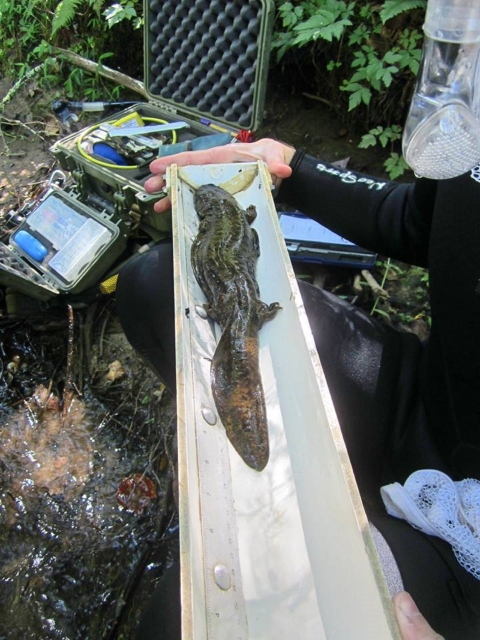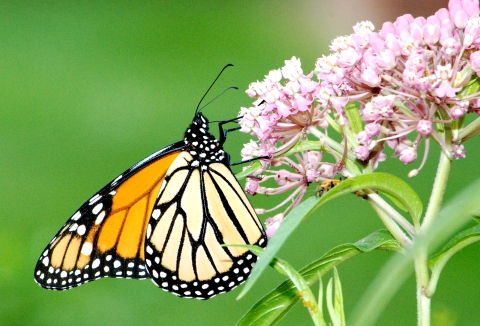Projects and Research
Bog Turtle
The Chattahoochee Forest National Fish Hatchery has been partnering with Georgia Department of Natural Resources surveying bog turtles in the northern Georgia for the past several years. The Southern population of bog turtles is considered threatened by association.
“Bog turtlesare perhaps the rarest reptile in the United States . . . Southern Appalachian mountain bogs are one of the most critically endangered wetland ecosystems in the United States . . . As the north Georgia mountains became settled and developed, low-lying and relatively flat areas, including bogs, were targeted as ideal locations for towns, roads, reservoirs, and farms. One of the main threats to bogs now is the takeover by trees and shrubs (succession), which shade out rare bog plants and animals that need full sunlight to survive. The result is the decline and loss of plants and animals associated with this habitat including the bog turtle and swamp pink plant . . .”
- Georgia Department of Natural Resources Wildlife Division.
Swamp Pink Plant
"Swamp pink is only found in wetlands along streams and seepage areas in freshwater swamps. The major threat to the species is loss and degradation of its wetland habitat due to encroaching development, sedimentation, pollution, succession, and wetland drainage. Swamp pink has extremely low seedling establishment, which appears limit establishment of population at new sites. Other threats include plant collection and trampling.
In order to remove swamp pink from the endangered species list, biologists must stabilize the range-wide status of the species by:
- securing permanent land protection for a minimum of 80 sites;
- ensuring long-term regulatory protection of all extant populations and their habitat at the state and local levels; and
- if needed, maintaining representative genotypes in cultivation."
- U.S. Fish and Wildlife Service
Purple Pitcher Plant
"The Mountain purple pitcher plant is a perennial herb with leaves modified into inflated pitchers. Pitchers are 2 - 18 inches long, often resting on the ground, and green with purple veins. The pitcher is widest at its middle, with a wing on the upper side and an erect, wavy-edged hood. Threats to the plant include ecosystem-wide hydrology changes due to habitat conversion, habitat loss, and fire suppression. Use of herbicides in powerline rights-of-way may have impacts on certain populations. Pitcher plants are also threatened by collectors and off-road vehicle use in some areas. Digging and rooting by feral hogs is also a threat to the species. Rangewide, the plant is considered rare with only a few dozen populations in mountain and seepage bogs of the Blue Ridge Mountains and adjacent piedmont of southwestern North Carolina (south of Asheville County), northwestern South Carolina (Greenville County), and northeastern Georgia (Rabun County). "
- U.S. Fish and Wildlife Service
Eastern Hellbender
As early as 1957 researchers noted the hellbender’s range was rapidly shrinking as a result of modification of stream habitats. Among the threats to stream habitats are the accumulation of silt, agricultural and industrial pollution, warming waters, as well as the channelization and impoundment of streams and rivers.
Hellbenders breathe primarily through their skin and rely on cool, well-oxygenated, flowing water. The construction of dams stops swift water flow, resulting in warmer temperatures and lower oxygen levels.
Although it is illegal in many states to sell hellbenders, the illegal pet trade may be contributing to the species decline.
How you can help
- Educate the public on the important role these animals play as indicators of healthy streams.
- Dispel myth that eastern hellbenders are venomous, which can lead to anglers killing the species when caught on a line
- U.S. Fish and Wildlife Service
Monarch Butterfly
Chattahoochee Forest National Fish Hatchery also serves a vital role in helping save the monarch butterfly and has established and maintains a butterfly habitat on the hatchery grounds:
“The monarch butterfly is one of the most recognizable species in North America and it’s in trouble. Monarchs inspire people; and their habitat supports pheasant, quail, waterfowl and many other species. Their habitat also provides outdoor recreation opportunities, like hunting and wildlife observation. Habitat loss and fragmentation has occurred throughout the monarch’s range. Pesticide use can destroy the milkweed monarchs need to survive. A changing climate has intensified weather events which may impact monarch populations.”
- U.S. Fish and Wildlife Service.







